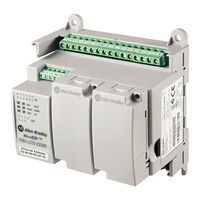Rockwell Automation 2080-LC20-20QWB Manuals
Manuals and User Guides for Rockwell Automation 2080-LC20-20QWB. We have 2 Rockwell Automation 2080-LC20-20QWB manuals available for free PDF download: User Manual
Rockwell Automation 2080-LC20-20QWB User Manual (350 pages)
Programmable Controllers
Brand: Rockwell Automation
|
Category: Controller
|
Size: 34 MB
Table of Contents
-
Preface11
-
RMC Memory25
-
Overview59
-
Modbus RTU61
-
Ascii61
-
Overview75
-
Function Codes100
-
DNP3 Object Data106
-
Event Reporting117
-
Generate Events117
-
Diagnostics124
-
Function Codes126
-
Execution Rules134
-
Optional Module134
-
Motion Control139
-
Axis States153
-
Limits154
-
Motion Stop156
-
Motion Direction157
-
Add New Axis163
-
Delete an Axis172
-
Monitor an Axis173
-
Mc_Home_Direct179
-
POU Pwm_Program181
-
PLS Operation206
-
PLS Example207
-
HSC Interrupts208
-
Protected Mode213
-
Exclusive Access213
-
Compatibility214
-
Controller216
-
Overview221
-
Data Log229
-
Recipe235
-
Modbus Mapping251
-
Performance256
-
Change Password269
-
Clear Password269
-
Forcing I/Os280
-
Troubleshooting303
-
Normal Operation305
-
Error Codes305
-
Fault Types305
-
How to Autotune318
-
PID Code Sample321
-
System Loading323
-
Controller323
-
Drop Link327
-
DF1 Full-Duplex328
-
DF1 Radio Modem329
-
Master Station334
Advertisement
Rockwell Automation 2080-LC20-20QWB User Manual (150 pages)
Programmable Controllers
Brand: Rockwell Automation
|
Category: Controller
|
Size: 10 MB
Table of Contents
-
Preface
7 -
-
-
-
-
-
Normal Operation110
-
-
Troubleshooting
109 -
Quick Starts
117-
-
Change Password126
-
Clear Password127
-
Forcing I/Os127
-
Index
145
Advertisement
Related Products
- Rockwell Automation Allen-Bradley 2080-LC20
- Rockwell Automation 2080-LC20-20AWB
- Rockwell Automation 2080-LC20-20AWBR
- Rockwell Automation 2080-LC20-20QWBR
- Rockwell Automation 2080-LC20-20QBB
- Rockwell Automation 2080-LC20-20QBBR
- Rockwell Automation 2080-LC20-STARTERPACK
- Rockwell Automation 2080-LC20-STARTERPACKL
- Rockwell Automation 2080-LC30-16QVB
- Rockwell Automation 2080-LC70-24AWB

